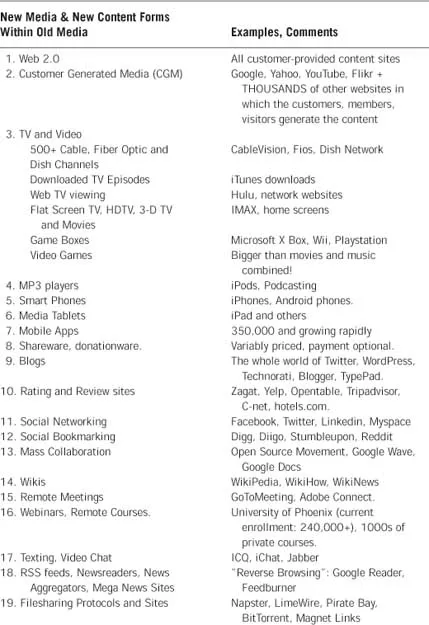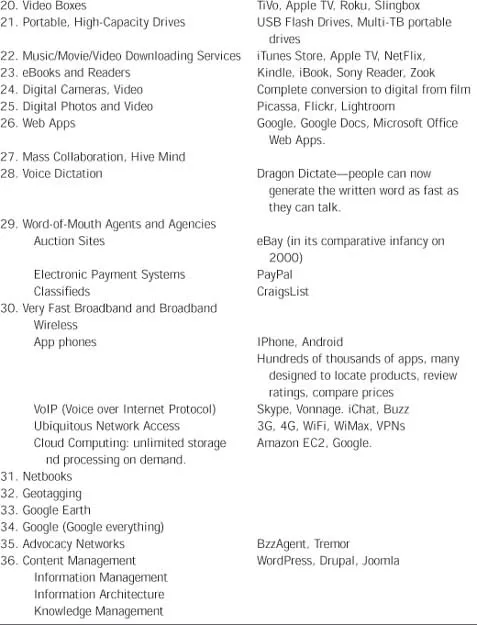![]()
CHAPTER 1
The Systematic Approach to Word of Mouth
If you are paying attention to what is going on in marketing, you will almost certainly feel disoriented and overwhelmed. I want to offer some perspective, reassurance, and encouragement. You are not alone. You are feeling the way everyone does in a revolution. And, we are experiencing several revolutions simultaneously.
The Digital-Information-Knowledge-Transportation-Communications-Internet-Marketing-Word-of-Mouth Revolutions
I’ll let you in on a little secret: No one fully knows what’s going on!
As writings during other revolutions show, it’s hard to see the significance of a revolution when you’re in the middle of it. It’s even harder to figure out what to do. History shows clearly that a significant number of people do nothing and get crushed by the people who panic, who are also crushed or, at least, badly injured. The ones who think and adapt usually survive. The visionaries prosper.
You cannot understand word-of-mouth marketing without the perspective of this broader context.
Some Perspective on Revolutions
There is a well-known pattern to attempts to gain perspective in the middle of revolutions, as shown in the following steps:
1. The insights, warnings, and predictions are ignored.
2. The predictors of the revolution are called ignorant, naïve, or crazy.
3. People in large organizations, who take the predictions seriously enough to investigate, are often fired.
4. The changes that start happening are denied outright.
5. The changes are said to be temporary signs of something else.
6. The changes are recognized, but they are called insignificant.
7. People say that the predicted changes were obvious and inevitable all the time.
8. People blame the experts for not seeing what was “obvious.”
9. The experts, of course, say that they knew it all along but no one would listen.
All of this rationalization and denial is compounded by some strong cognitive biases:
We tend to underestimate the likelihood of what’s hard to imagine and overestimate the likelihood of what’s easy to imagine.
We want to cling to the predictable, which is hard enough to cope with.
A few people take the predictions seriously, investigate, see the opportunities, and profit hugely. They’re disparaged as exploiters.
Great discomfort is caused by fundamental change and the necessity to rethink, relearn, repurpose, and reinvent that it inevitably causes. It may be exhilarating to some of us, but it’s also scary.
It’s much easier to stay the course. The status quo is a comfortable refuge and a pretty good strategy when change is slow and things are working. It’s a terrible solution in the middle of a revolution, and a disaster in the middle of simultaneous revolutions.
All of the above is why some people are still stuck in the old ways of marketing.
The Secret to Surviving and Prospering in a Revolution
I’ve learned that it’s important to resist the false choice between clinging to the status quo and jumping into the sea of change. The better choice is to fly above the sea of change. Not so high that you get into the clouds, but high enough that every little wave isn’t so distracting that you can’t see what’s ahead.
The most useful principle I’ve learned to cope with all the change and uncertainty from inside the revolutions is that we learn at the edge of our own incompetence and ignorance. We have to step right up to the edge of what we don’t know and become involved, but not submerged. In doing this, people feel stupid and inept, but people who try to avoid ever feeling stupid and inept don’t learn.
So, we’ll ask a lot of “stupid” questions and struggle with partial, inadequate answers, try a lot of things that don’t work out, and profit hugely from the few that do.
I’m reminding you of all this to try to immunize you. I hope you will embrace the struggle to understand a world that’s changing on so many levels at the same time.
In the first edition of this book, I made the following predictions that sounded wild at the time:
“I believe that this book is the beginning of a historic turning point in marketing, which will spawn an entire industry, the word-of-mouth marketing industry.” It did: new communication tools, agencies, websites, and more—all functioning by different rules from conventional marketing.
Word-of-mouth marketing would overshadow the traditional marketing media, which would go into decline. TV, magazines, direct mail, telemarketing, movie theaters—and many more marketing media—are declining in the shadow of word-of-mouth marketing.
Many major companies would stick with traditional marketing and be clobbered by much smaller companies using word-of-mouth marketing. Many Davids would slay many Goliaths. The specific examples I gave (GM, the old AT&T, IBM) came true with uncanny accuracy.
The Word of Mouth Marketing Association (WOMMA) was founded. New techniques were exchanged. Stories of intentional stimulation of word of mouth became commonplace. Ethical standards were issued. Agencies were founded. And, sadly, many opportunists and con artists became attracted to word-of-mouth marketing once they realized its power and potential for manipulation. In other words, the industry I predicted was formed.
When the first edition was published, limited media were available for implementing word-of-mouth marketing. I had to search for examples, using more pharmaceutical industry and teleconferencing techniques than I would have liked because only that industry had embraced word-of-mouth marketing—and the industry used my teleconferencing techniques as its main tool.
Now the number of options is overwhelming, even to people in the new word-of-mouth industry. By the time you read this book, there will be hundreds of new social networks, mash-ups, websites, apps, platforms, categories, techniques, gizmos, communication channels, and other media.
The current Information Revolution compares in impact with the Renaissance. We’re in the middle of an extended, expanding chain reaction, an explosion of technology that is feeding on itself, that shows every sign of continuing to accelerate unless society collapses from its complexity—one that allows us to build way beyond what we fully understand.
Instead, we need a conceptual approach, one developed from a perspective that doesn’t get lost in details. We need a systematic approach to word of mouth.
What Do I Mean by “Systematic”?
I’m going to lay out where to start, what questions to ask yourself, what’s important versus what might bog you down, where to find the answers, and how to proceed. The more complicated something gets, the more you need fundamental principles to guide you through the details—even those details that haven’t yet been invented!
We all want to get to the “nuts and bolts” right away because we want practical experience in the real world, and we have pressing things to accomplish. So, we jump right in before getting our bearings, before learning the key principles that are the secrets.
The Dot-Com Super Bowl
On January 31, 2000, at the height of the dot-com boom, about a dozen dot-coms aired 30-second commercials during Super Bowl XXXIV at a cost of $2.2 million each, the entire marketing budget for some, in the hope that—with hundreds of millions of people watching—they would put their unknown companies on the map and establish a corporate identity. I was appalled and publicly called it the worst case of advertising agency malpractice I had ever seen. Either their ad agencies knew better or they should have. In either case, the agencies were, in my opinion, negligent.
The dot-com bubble burst soon after. The Super Bowl advertisers found that they could not establish a corporate identity in a 30-second TV spot. They found that they could get everyone talking about their quirky commercials all right, but that wasn’t the same as getting people to rave about their products’ benefits. With one or two exceptions, all of the advertisers on that Super Bowl went out of business.
It became known as the Dot-Com Super Bowl and, in many people’s minds, it not only marked the end of the dot-com bubble, it marked the beginning of the end of the Old Marketing, perhaps symbolized best by the pets.com sock puppet.
Fortunately, the “too big to fail” mentality hadn’t caught on yet, so the dot-coms were allowed to “creatively destruct.” What nobody realized was that the dot-coms, ironically, were using the old media to sell the new media. Heck, they were the new media!
The New Media
The new media consists of more than technical improvements (i.e., the improved version of the old, like going from regular to high-definition TV). They are supplanting the old media because something is changing fundamentally.
It’s hard to believe, but in the few short years since that fateful Super Bowl XXXIV, the media and contents listed in Table 1.1 emerged. They weren’t even mentioned in the first edition of this book because either they didn’t exist or hadn’t caught on yet. Table 1.1 isn’t a complete list, and the categories are fluid and overlapping, but it does give you a flavor of how many new media have hit us in the last ten years. Note: Don’t get caught up in the details. No taxonomy has emerged. Some of these categories are new media; others new forms, packages, delivery systems of the old media. The point to understand is the staggering interconnected array of new “stuff” that has gradually hit all of us in only the last ten years, since the first edition of this book. The point is that we are flooded with new input—overloaded with new ways of getting content and overwhelmed by the content itself. Someone said we are trying to drink from the fire hose. No. We are blasted by dozens of fire hoses, and we are neither thirsty nor on fire.
Some of these categories have hundreds to thousands of individual examples: thousands of eBay merchants, rating sites, travel sites, mash-ups, and so on.
Remember when we all had AOL accounts, brick-like cell phones and dial-up modems, we used Yahoo as our search engine and asked our friends if they had email? That was right around 1997.
Gone—or almost gone—are faxes and faxback, hotlines, pagers, classified advertising, newspaper stock listings, physical dictionaries, encyclopedias, thesauruses, physical recording media such as floppy disks, records/cassettes/CDs/DVDs (almost), PDAs, camera film, simple bulletin boards/forums, dial-up modems, printed maps, traveler’s checks, telegrams, travel agents, and pay phones. Soon to be obsolete (or nearly so) are paper-based books, brick-and-mortar bookstores, handwritten prescriptions, land lines, paper money, major broadcast TV networks, and cords connecting anything.
Table 1-1
Emergence of New Media/Sources/Content/Forms, etc., Since 2001
But their absence doesn’t create a lot of room. Every one has been replaced by a multitude of more accessible new forms to flood our senses.
It all comes down to: OVERLOAD
Notice that the new arrivals almost all increase our interactivity and connectedness, and, thereby, our overload. They also increase our ability—actually necessity—to engage in word of mouth. These changes have totally transformed the marketplace and marketing. Marketers at first thought that the Internet was a cheap way of delivering a brochure. Some still do.
SECRET
Involvement and collaboration is what it’s all about now.
SECRET
The new media have brought a level of overload that is unprecedented.
We went from the handwritten word to the printed word in centuries. Then, in a few decades, we moved from information scarcity and relative isolation to broadcasting. Now, we have moved from tuned-in to interactive and participatory in just a few minutes (Okay, a few years that felt like minutes).
You will have an enormous advantage over other marketers if...













